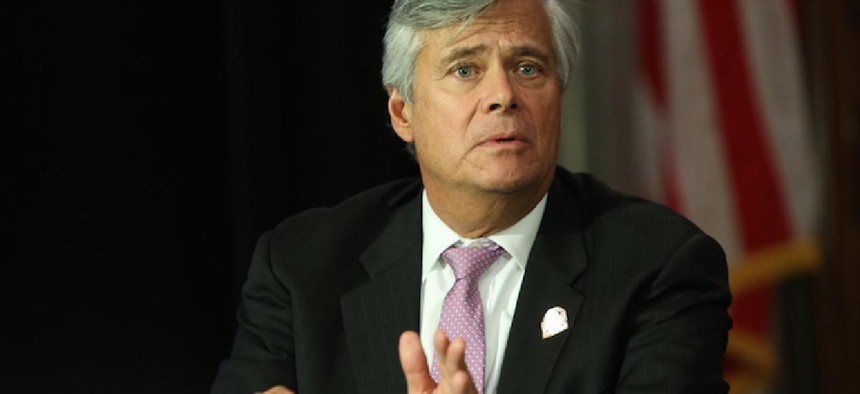Political scandals have a tendency to turn special elections in New York state into significant political turning points.
The vacancy that Dean Skelos’ corruption conviction created in Nassau County’s 9th district state Senate seat has spawned another of these talisman special elections in 2016. The outcome will pivot less on the mechanics and logistics of campaign techniques than on which prospective candidate crafts a compelling narrative.
Let’s parse the particulars of this looming rumble from Rockville Centre.
First, there will be no actual registration advantage in this special election. Among the district’s nearly 230,000 registered voters, 41 percent are Democrats, 34 percent are Republicans and 25 percent are unaffiliated (i.e., what we call independents) or members of third parties. As turnout drops in a special election from the presidential election level there likely will be partisan parity (erasing Democrats’ 7 percent registration edge). Consequently, the winner of this special election will have to carry independents.
Second, in recent years Nassau’s independent voters have gravitated sharply toward the Republicans. That trend held true from 2009 through 2014, but in last year’s county district attorney race independents shifted decisively away from the GOP standard bearer, Kate Murray, toward Democrat Madeline Singas on the issue of fighting corruption. Therefore, if the corruption issue does not end with Skelos’ conviction but leaches into the guts of the Nassau County GOP, especially given the rumors surrounding Deputy County Executive Rob Walker and County Executive Ed Mangano, the Democrats have an opening with independents.
Third, the Democrats have a central casting anti-corruption candidate in Long Beach Assemblyman Todd Kaminsky. Kaminsky was a productive leader in Loretta Lynch’s public corruption unit from the US Attorney’s office for the Eastern District (e.g., the lead trial lawyer on the Pedro Espada conviction).
The Republicans have a more difficult choice in terms of candidate selection. In any other year, Assemblyman Brian Curran from Lynbrook would be a strong candidate to bond independent voters to the GOPs base vote, but last year’s DA race should give the party pause. Kate Murray was a popular town supervisor, but as a product of the GOP machine she had no standing or experience in battling corruption in the eyes of voters. Whether Curran can fit the contours required for this campaign remains an open question.
Fourth, the stakes are high for the Republicans. The Senate Republican Campaign Committee is not only well funded, it also has a strong recent track record of winning tough races, especially on Long Island (e.g., Kemp Hannon in 2008 and 2012, Lee Zeldin in 2010, Jack Martins in 2012, and Tom Croci in 2014). The SRCC has also proved highly effective in nurturing narrative campaigns (last year’s special election for Tom Libous’ seat won by Fred Akshar in a complete blowout).
The Senate Republican leader, John Flanagan, is from Suffolk and knows full well that holding all nine Long Island Senate seats is the keystone for Republicans maintaining their Senate majority.
Fifth, given the changing demographics of this district in terms of registration, racial and ethnic diversity (just under a quarter of the district is black and Hispanic and just over 5 percent of the district are Asians, according to the Census) with an active and growing Orthodox and Hasidic Jewish community, not to mention the high levels of highly educated, often affluent voters, mixed in with blue collar communities, different issues will cut different ways. The candidates must choose wisely to win votes.
I have a hunch that in this district as many and probably more Democrats will vote in their presidential primary than Republicans in this district, even if the Democratic race is largely over. In recent years, it is upstate Republicans who flock to the polls in statewide primaries, not downstate Republicans (e.g., the 2010 Paladino-Lazio gubernatorial primary).
This special election will come down to a battle of competing narratives. The Republicans will frame it as a run against liberal New York City Mayor Bill de Blasio (i.e., portraying the Democratic candidate as a beholden to city interests, mirroring their successful 2014 campaigns). Alternatively, the Democrats will run against the stench of corruption looming over Nassau’s GOP machine. The message discipline that worked so effectively in Singas’ landslide DA win could be in play here. Which competing narrative takes hold with voters will prove determinative.
Turnout will indeed be a huge factor in the outcome. But not all special elections are boring, low-turnout affairs. Sometimes the hot spotlight from the media lights a fire, as happened in past special elections to Congressman Robert Garcia, Assemblymen Charles Ronald Johnson and Eliot Engel, Senators Craig Johnson and Darrel Aubertine and Congresswoman Kathy Hochul, as each won races the early handicapping had deemed longshots.
In the final analysis, I would not place a bet on this special election until the potency of the candidates’ narratives can be measured. Therefore, the late betting on the outcome will be the smart money.
Bruce Gyory is a political and strategic consultant at Manatt, Phelps & Phillips LLP and an adjunct professor of political science at SUNY Albany.
NEXT STORY: Podcast: The Rumble in Central New York


